 For
a full overview click
here
For
a full overview click
here  For
a full overview click
here For
a full overview click
here The Leicester Time trailby Alan Mills |
|---|
Astronomical BackgroundThis page is about how time has been measured over the centuries, using examples that may be seen within the City of Leicester. Two natural measures of the passage of time are:
These two timescales have been important to mankind since the earliest cultures, both for regulation of daily life and to know when to sow and harvest crops. The motion of the EarthThe spin axis of our planet is inclined at 66½ to the plane of its orbit around the Sun,, and (over human timescales) always remains pointed near Polaris, the Pole Star. This is shown diagrammatically in Fig.l.
As a result, the Sun is said to change in declination over the year, and its daily path across the sky curves in a clockwise arc which rises higher during the summer months than in winter (Fig.2).
The changing angle of illumination gives rise to the longer period of daylight and more intense warming that we associate with summer. Divisions of the yearThe day when the Sun crosses the sky in its highest arc is called the summer solstice, whilst the lowest arc characterises the winter solstice. The halfway points between these two extremes, when the Sun rises exactly east, sets exactly west, and is above and below the horizon for equal periods of time, mark the vernal (Spring) and autumnal equinoxes (Figs.1 & 2). These points give rise to the conventional division of the year into the four seasons. Divisions of the dayLong ago, Mesopotamian civilisations found that the natural two-fold division of the entire day into daytime and night required further subdivision. (The English language is imprecise here: when we use the word 'day' we have to distinguish by the context whether we mean the entire day or the sunlit portion of it.) They therefore divided the period between sunrise and sunset into twelve equal parts, with six intervals before midday (when the Sun is at its highest) and six after it. It will be seen from Fig.2 that these periods of time are not equal through the year: they must be greater to divide the long days of summer, and shorter in winter. These intervals are therefore called seasonal hours. In due course the night too was sub-divided into 12 parts, giving rise to the 24 hour system that is still in use everywhere, although the duration of the hours themselves has changed. Our modern equal hours - of equal length by day and by night throughout the year - were not widely used until the spread of the mechanical clock in the 14th and 15th centuries. They are equivalent to the seasonal hour at the equinoxes. SundialsThe exact position of the Sun in the sky defines both time of day and time of year. However, it is too bright to look at directly, so mankind has traditionally used shadows to keep track of the Sun's position. Originally the shadows of trees (or even oneself!) would have been noted on the ground. Midday ('noon') is then marked by the shortest shadows of the day, which then lengthen again as the afternoon progresses. Instruments - sundials - were set up to delineate the hours more accurately. A few are known from ancient Egypt, but as their mode of working is not well understood they will not be considered here. Graeco-Roman sundialsThe ancient Greeks were the first people to design an accurate sundial marking both time of year and time of day, the latter in seasonal hours. The innovative step was to let a part-spherical cavity hollowed out in a block of stone represent the sky, and have a gnomon positioned with its point at the centre of the bowl (Fig.3).
This instrument was called a hemicyclium: another form was based on sections of a cone.
The depth of the shadow's arc within the bowl is controlled by the height of the Sun, and so indicates the time of year. Usually only three arcs were inscribed: that of the winter solstice at the top, the equinoxes in the middle, and the summer solstice at the bottom. It is obvious that the last-named contains the longest seasonal hours. The Leicester hemicyclium
A full-size working reconstruction of a public hemicyclium (Fig.5) has therefore been installed in this museum. Carved from Clipsham stone, it is the only accurate reconstruction known to have been made in modern times. Visitor-controlled lighting shows how the dial gave both time-of-day and time-of-year. Water ClocksA water clock or clepsydra utilises the flow of water issuing as a fine jet from a large vessel to measure the passage of time. The Karnak clepsydraIn 1904, archaeological excavations within the ancient temple complex of Karnak in Egypt led to the recovery of fragments of a large conical vessel. The presence of an outlet near the base, plus calibration scales on the interior walls, showed the object to be a classic example of an outflow clepsydra.
The hieroglyphics covering the outside of the vessel (delineated by Dr. Sarah Symons) do not explain how the water clock was to be used: they are simply traditional decorations in praise of the gods. More information is given alongside the exhibit.
|
| Click on the links below to see a map showing the exact location |
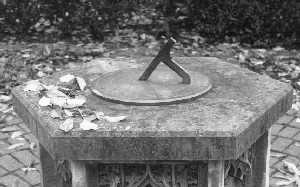 The
shadow cast by the stile of the gnomon may be intercepted by calibrated
dials in various planes. Commonest is the horizontal dial that is a
favourite in private gardens, but unfortunately this design is susceptible
to vandalism if erected in a public place.
The
shadow cast by the stile of the gnomon may be intercepted by calibrated
dials in various planes. Commonest is the horizontal dial that is a
favourite in private gardens, but unfortunately this design is susceptible
to vandalism if erected in a public place. 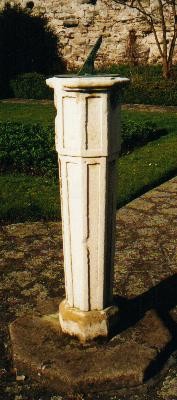 For
this reason a fine brass dial once in Museum Square (alongside New Walk
Museum) has had to be removed to storage.
For
this reason a fine brass dial once in Museum Square (alongside New Walk
Museum) has had to be removed to storage.
However, horizontal sundials may still be seen in Prebend
Gardens (Fig.9) and in the garden of Newarke
Houses (Fig.10) 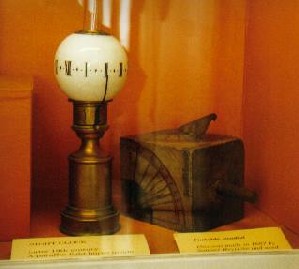 An
interesting multiple sundial with faces on the sides of a cube is displayed
inside this museum. It was made in 1687 by Samuel Heyricke (Fig.11)
An
interesting multiple sundial with faces on the sides of a cube is displayed
inside this museum. It was made in 1687 by Samuel Heyricke (Fig.11)
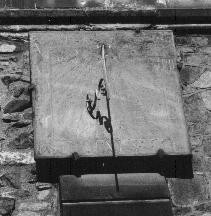 More
practical for public installation is the vertical dial, where the dial
plate is fixed high up on a wall. The latter need not face exactly south
but, as always, the stile of the gnomon must point up at the Pole Star.
Vertical dials may be viewed on the church of St.Nicholas
(Fig.12), and on Leicester
Cathedral (Fig.13),
More
practical for public installation is the vertical dial, where the dial
plate is fixed high up on a wall. The latter need not face exactly south
but, as always, the stile of the gnomon must point up at the Pole Star.
Vertical dials may be viewed on the church of St.Nicholas
(Fig.12), and on Leicester
Cathedral (Fig.13), 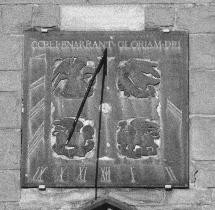
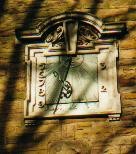
Other vertical dials are on the old Trinity
Almshouses (Fig.14) now part of DeMontfort University, and the St.Martin's
Square shopping mall (Fig.15). An unusual matching pair of vertical dials may be seen at the northern
end of the campus of Leicester
University. Mounted above the entrance to the Bennett Building (containing
the Departments of Geology and Geography) the left-hand dial shows the
time in seasonal hours, whilst the right-hand dial employs a triangular
gnomon and is calibrated in equal hours (Fig.16).
An unusual matching pair of vertical dials may be seen at the northern
end of the campus of Leicester
University. Mounted above the entrance to the Bennett Building (containing
the Departments of Geology and Geography) the left-hand dial shows the
time in seasonal hours, whilst the right-hand dial employs a triangular
gnomon and is calibrated in equal hours (Fig.16).
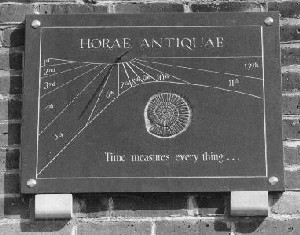
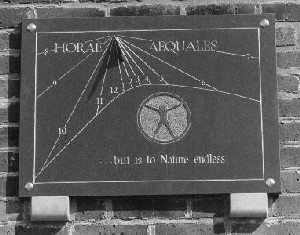
As the supporting wall does not face true south, these dials are said to be of the declining type. More details are given on a nearby plaque.
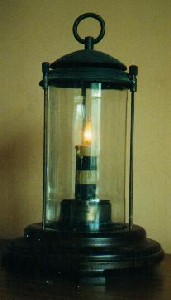 The
sandglass has a surprisingly recent history, apparently dating from
medieval Europe rather than being known along with the clepsydra in
ancient Egypt, Greece or Rome. This is especially remarkable since sand
is so abundant there, its rate of flow is independent of the depth in
the upper reservoir, and the instrument is not liable to freeze.
The
sandglass has a surprisingly recent history, apparently dating from
medieval Europe rather than being known along with the clepsydra in
ancient Egypt, Greece or Rome. This is especially remarkable since sand
is so abundant there, its rate of flow is independent of the depth in
the upper reservoir, and the instrument is not liable to freeze.
The first reliable pictorial representation dates from AD 1338, whilst the earliest written records are in lists of ships stores from the same 14th century period. These ½ hour glasses appear to have been used (with repeated turning) for navigation and to time the duration of each 4-hour watch: not until late in the 16th century were ½ minute versions combined with a 'log' to give a ship's speed through the water. From the 15th century the use of the sandglass to define the duration of sermons, lessons, manufacturing and culinary purposes etc. became commonplace, but today only the egg-timer remains familiar. A sandglass once used by auctioneers is exhibited at Newarke Houses (Fig.17)
The candle clock is always associated with King Alfred, but beeswax was far too valuable for this to be of general application.
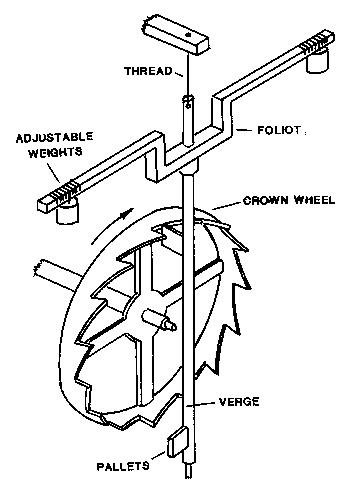 The
mechanical clock appeared in Europe towards the end of the 13th century,
with no clear precursor or inventor. The principle was that an elevated
weight (acting as a source of energy) was allowed to descend ('escape')
in small steps when released by a mechanical device known as an escapement.
For the first time we see the smooth unidirectional flow of time being
broken-up and measured by an intermittent process - an oscillator.
Oscillation continues to be used in precision timekeeping, although
quartz crystals and caesium atoms are now the preferred oscillators.
The
mechanical clock appeared in Europe towards the end of the 13th century,
with no clear precursor or inventor. The principle was that an elevated
weight (acting as a source of energy) was allowed to descend ('escape')
in small steps when released by a mechanical device known as an escapement.
For the first time we see the smooth unidirectional flow of time being
broken-up and measured by an intermittent process - an oscillator.
Oscillation continues to be used in precision timekeeping, although
quartz crystals and caesium atoms are now the preferred oscillators.
The earliest escapement is the 'verge and foliot', where an oscillating arm bearing adjustable weights rotates back-and-forth to release a 'crown wheel' with ratchet-like teeth (Fig.18). A working replica illustrating this action may be seen at the Newarke Houses museum. At best, this device was accurate to only about ±15 minutes per day, so was soon replaced when the pendulum (with its inherent timekeeping qualities) was applied to the clock by Galileo and Huygens. As with the verge and foliot, the weight drove the pendulum, but the pendulum controlled the descent of the weight.
The earliest verge and foliot clocks may well have been used in monasteries as 'alarm clocks', to rouse the monk whose duty it was to awaken the brethren for the first service of the day. As such, the sounding of a small bell (or 'glock') might be the simplest warning signal, so giving rise to our word 'clock'.
By the end of the 16th century, when timekeeping quality had improved, it became worthwhile to fit a single hour hand, moving over a numbered dial. This hand imitated the Sun by arcing from left to right ('clockwise') over the top half of the vertical dial, with 12 noon painted at its highest point. The clock became a prestige object - following the abbeys and monasteries every town and village wanted one on their church tower - so the public clock spread across Europe.
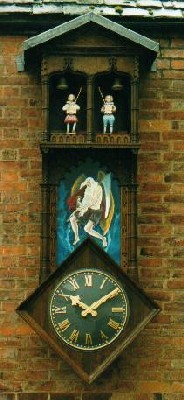 A
rather brief interlude in the history of clockmaking was for the hour
to be announced by mechanical figures - automata or 'jacks' - striking
(or pretending to strike) an external bell or bells. The number of strokes
gave the hour, and could be heard in places where a dial (even if fitted)
could not be seen.
A
rather brief interlude in the history of clockmaking was for the hour
to be announced by mechanical figures - automata or 'jacks' - striking
(or pretending to strike) an external bell or bells. The number of strokes
gave the hour, and could be heard in places where a dial (even if fitted)
could not be seen.
The automaton clocks at Wells and Exeter Cathedrals are famous, but less well known is the fact that Leicester once had an automaton clock. Its remains may still be seen above the porch of All Saints' Church, Highcross Street. This clock was restored in 1899, and to a lesser extent in 1926 (Fig.19). Tragically, the old movement was discarded, but it is claimed that original timbers were incorporated where possible in the external clockcase. So too were two carved wooden jacks traditionally dating back to Jacobean times; certainly from old photographs their dress agreed with that of heralds at a date around 1610. Unfortunately, both jacks were stolen in the early 1980's, when the church, became redundant.
A re-creation of this clock has been made, and hung in the inner courtyard of the Guildhall. The carved oak case and reproduction jacks were made by Kenneth Rose, and 'Old Father Time' painted by Christopher Mills. The external size and appearance of the clock follows that of the original, but the modern electrical mechanism (made by Colin Clarke) is controlled by a microprocessor.
Increasing accuracy justified the addition of a minute hand, and the well-known longcase ('grandfather') clock owed its basic design to the incorporation of a long pendulum beating seconds, plus the need for a considerable drop for the driving weights. Clocks appeared increasingly in homes in the 18th and 19th centuries.
The Newarke Houses Museum contains a notable collection of longcase clocks by Leicestershire makers, particularly the Deacon family of Barton-in-the-Beans. Remarkably, much of the original workshop established by Samuel Deacon in 1771 has survived, and now forms one of the reconstructed period shops on the ground floor.
The final goal of the clockmakers' art was to construct a clock showing the relative movements of the Sun, Moon and stars as accurately as possible. The underlying problem is that Sun (civil) time, lunar (tidal) time and star (sidereal) time are not integrally related to one another, and any small discrepancy in ratio soon builds up into an obvious error. The Moon rises on average some 50 minutes later each day, whilst the starry background appears to complete one turn in about 23 hours 56 minutes. Gearing of varying sophistication is used in the well known monumental astronomical clocks of Hampton Court, Wells, York, Prague etc.
The modern solution is to employ three independent quartz crystal oscillators to generate impulses based on solar, lunar and sidereal time. A large public astronomical clock utilising this electronic system may be seen on an exterior elevation of the Rattray Lecture Theatre at the University of Leicester (Fig.20). It was installed in 1989.
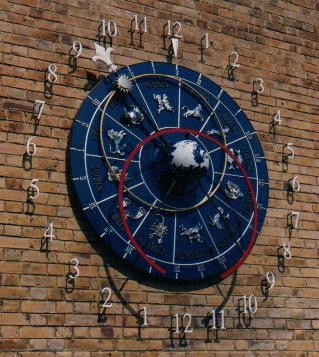
|
The text of
this page is from a leaflet called: |
Web page and design copyright © 2001 Allan Mills and Internetworks Ltd